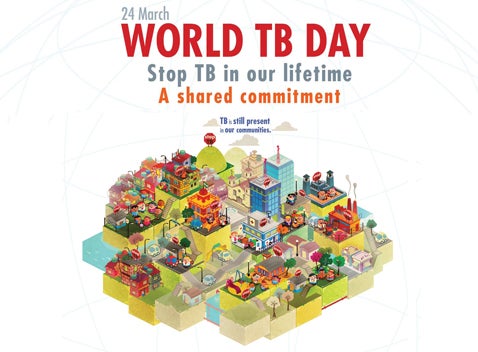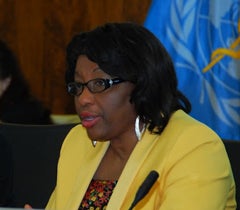In 2011, 268,000 new TB cases and nearly 30,000 deaths were reported in the hemisphere
Washington, D.C., 19 March 2013 (PAHO/WHO) — The Pan American Health Organization/World Health Organization (PAHO/WHO) today called for stepped-up efforts to prevent and control tuberculosis in the Americas, especially in vulnerable populations living in large cities.

Despite significant advances against TB, the disease continues to be the second-leading infectious cause of death in Latin America and the Caribbean, after HIV/AIDS.
In 2011, there were an estimated 268,000 new TB cases and some 30,000 TB deaths (including people with HIV) in the Americas. Estimates suggest, however, that some 60,000 new cases went undiagnosed during the same period, most of them in urban areas.

"We call for efforts to reach the goal of zero TB deaths, a goal that can be reached only if inhabitants of the Americas can live healthy and enjoy universal access to quality health services without the fear of being impoverished," said PAHO Director Carissa F. Etienne during a special event marking World TB Day, March 19, at PAHO/WHO headquarters.
The burden of TB varies across countries and is concentrated in vulnerable populations, such as ethnic minorities, migrant groups, and those with poor access to medical care. These populations tend to live in marginal urban neighborhoods with poor living conditions, including overcrowding and violence, and impacted by economic inequality, unemployment, and violence. One in four urban residents in Latin America lives in poverty.
"The fragmentation of health systems, the lack of comprehensive care for patients and the failure to adapt care to the needs of the most disadvantaged populations —such as ethnic minorities, women, children, and the elderly— contribute to a situation in which not all enjoy the benefits of timely diagnosis and treatment for this disease," said Etienne.
This year, PAHO/WHO is celebrating World TB Day with the slogan "Stop TB in our lifetime -- a shared commitment." A key message is that TB prevention and control can be improved through strategies that emphasize multisectoral action in areas including education, access to health services, improved housing and general living conditions and the provision of sanitation services in marginal areas.
"A shared commitment means that ministries of health, human development, economy, housing, education, and others are called on to make the control of tuberculosis an agenda priority," said Etienne.
With support from the U.S. Agency for International Development (USAID), PAHO/WHO is implementing a TB control initiative in large cities in Latin America and the Caribbean. The initiative takes a comprehensive approach and addresses the needs of the most vulnerable communities in areas including education, employment, urban development, and health.
"We are looking forward to the time when no country has tuberculosis and every country has universal health coverage," said Ariel Pablos-Mendez, USAID administrative assistant for global health.
In a panel focused on successful experiences in urban TB control, Peru's Vice-Minister of Health José Del Carmen Sara described a multisectoral alliance that has carried out TB interventions in Lima ranging from medical care to housing and employment promotion in vulnerable populations.
Minister of Health of Guyana Bheri S. Ramsaran said his country was developing a comprehensive TB strategy that includes decentralization of services and housing programs, among other elements.
Vice-Mayor Carlos Derman of Guarulhos, São Paulo, Brazil, described a TB initiative in his city that emphasized detection in primary healthcare services for specific populations. Ana Zulema Jiménez Gómez, a top health official from Bogota, Colombia, described interventions carried out in her city, including efforts focused on indigenous minorities living in the city's outskirts.
Between 1990 and 2011, deaths from TB declined 61% in the Americas, and TB prevalence declined 62% TB. Progress in the region's countries has been achieved largely through the implementation of WHO's Stop TB Strategy, with PAHO support. The strategy emphasizes timely diagnosis and universal treatment with proper combinations of anti-TB drugs.
Despite the steady progress, countries in the Americas still face obstacles to TB elimination. These include the spread of MDR-TB, or multidrug-resistant tuberculosis; an increase in coinfections of TB and HIV/AIDS; and health system weaknesses in many high-TB-burden countries, particularly in primary health care.
About TB
TB is caused by Mycobacterium tuberculosis, a bacterium that most often affects the lungs. About one in three people worldwide has latent TB, meaning they are infected but have no active symptoms of the disease and cannot transmit it.
TB is spread through the air when people with active lung infection cough, sneeze or spit. The lifetime risk of someone infected becoming ill is 10%. However, people with compromised immune systems, such as those with HIV, malnutrition or diabetes, or people who use tobacco, have a much higher risk of falling ill. Symptoms of pulmonary TB include a cough that lasts for more than 2-3 weeks, weight loss, fever, night sweats, loss of appetite and coughing up blood. The disease is curable but can be fatal if left untreated. Treatment usually takes six months and costs as little as US$100 in many developing countries.
World TB DAY, March 24
World TB Day commemorates the day in 1882 when Dr. Robert Koch announced that he had discovered the cause of tuberculosis, the TB bacillus. At the time of his announcement in Berlin, TB was raging through Europe and the Americas, killing one out of every seven people. Koch's discovery opened the way toward diagnosing and curing TB.



